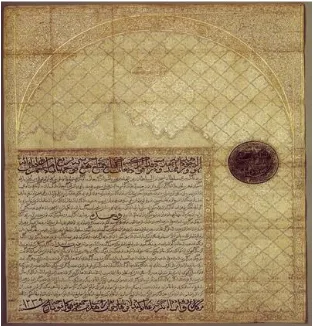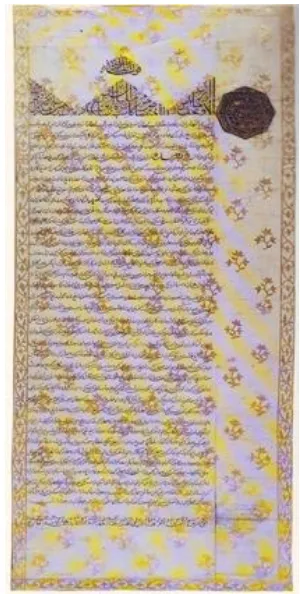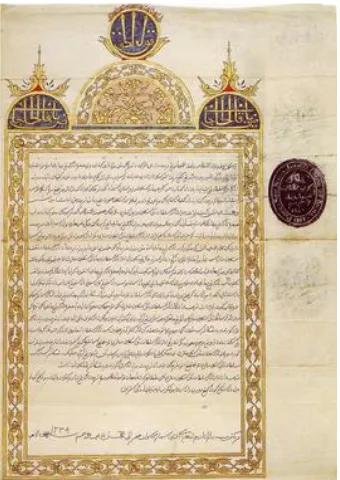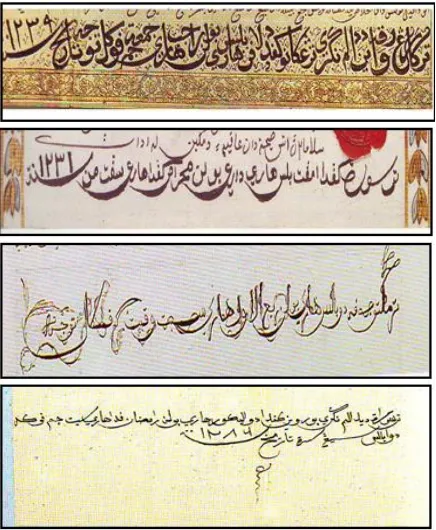Online version available in : http://arbitrer.fib.unand.ac.id
JURNAL ARBITRER
| 2339-1162 (Print)| 2550-1011 (Online)|
Article
Illumination and Calligraphy in Malay Letters
Ab. Razak Ab. Karim1, Reniwati 2,
1Academy of Malay Studies University Malaya, Malaysia
2Minangkabau Department, Faculty of Humanities University Andalas, Indonesia
SUBMISSION TRACK A B S T R A C T
Recieved: October 02, 20117 Final Revision: November 12, 2017 Available Online: December 27, 2017
Malay manuscripts contain all kinds of knowledge. The manuscripts not only tell stories, they also depict various knowledge within the minds of past generations. In this paper discuss elements of illumination and the use of calligraphy in Malay letters on past Malay letters. I limited the discussion to Malay letters in social letters in the period 1521-1899. Malay society in the olden days practiced very fine arts as shown in the Malay letters through illumination and through the use of various types and designs of calligraphy. They used the world of nature to express their feelings. This paper will reveal that the traditional Malay society was not impoverished of art, that they had the highest aesthetic value in art, even beyond comparison with the present.
KEYWORD
letters, illumination, calligraphy, Malay
CORRESPONDENCE
Email: abrazak@um.edu.my reniwati.fsua@gmail.com
I. INTRODUCTION
Malay manuscripts represent our national treasure and they contain all kinds of knowledge. The manuscripts not only tell stories, they also depict various knowledge within the minds of past generations. These include knowledge on Islamic jurisprudence, medicine, laws, contracts etc. thereby the effort of the Malaysian National Library, through its Malay Manuscripts Division in trying to unearth these national heritage should be lauded. They represent a most creditable effort and should thereby be pursued in the interests of Malay society, race and the nation.
In this paper, I intend to discuss two basic issues, and they are elements of illumination and secondly, the use of calligraphy in Malay letters. But my focus would be on Malay letters of the olden days mainly because of the
widespread use of illumination in the letters and a lot can be said on this. I limit my discussion to Malay letters, i.e. social letters only1, and letters under scrutiny covered the 1521-1899 period. Within this time span, hundreds of social letters were dispatched by the authorities, rulers or by westerners. Meanwhile contract letters were confined to specific areas or parties, mainly between the rulers and the west, i.e. the Dutch2.
II.RESULT AND DISCUSSION
Illumination in Malay Letters
drawings in letters. This delightful practice has been handed down from the past and has found popularity in Malay letters3.
An interesting feature of the Malay decorative arts is the absence of fauna, i.e. the rare use of animal figures in the drawings. Somehow this seems appropriate with Islamic teachings which forbid the use of animals in any kind of decoration4. For that reason, writers and decorators turn to coloured pictures with leaves and flora as the motif. Geometric patterns were also popular. There is also an abundance of flowers such as flowers of the clove, frangipani, water lily, jasmine and other common Malay flowers. This aspect of decorating has immense appeal, especially if
one looks at the ‘golden letters’5 which
display the highest quality in decorative arts. Those letters with illuminations serve to reflect the senders high standard and elevated status compared to other folks. Thus in Malay letters, a sender would use a certain type of illumination to symbolize the sender’s person. In truth, the receiver of a letter, upon examining the illuminations enclosed in a letter would be able to guess the identity of the sender. Generally, illuminations present in Malay letters can be divided into two categories. The first is letter with full illumination, and the second is letter with partial illumination. Full illumination letters have decorations covering the entire page. Flowery patterns are most commonly used. Whereas, in partial illumination letters, only a small section of the page is decorated. Examples of illuminated letters are shown below.
The sender of this letter is Sultan Iskandar Muda, the ruler of Acheh from 1607-1636. Upon examination, this particular letter is a most impressive golden letter that comes beautifully decorated. The decoration displays Ottoman Turkish influence, especially in the use of the poppy flower to fill in the section to the left, right, above and below the letter6. One could see an arch with decorative traditional patterns given a blue colour combination with white, yellow and red flowers. The oldest letter with this kind of
illumination happens to be one of the letters from Acheh to the English Monarch in the 17th Century.
Figure 1. A letter from Sultan Acheh Iskandar Muda to King James I of England in 1615.
(Source: Gallop, A.T. & Arps,B. (1991:35)
Figure 2. De Klerk’s letter to Sultan Muhammad Bahauddin Palembang dated 1779.
With regards to Example 2, the letter was sent by a Dutch official, i.e. the Governor General R. De Klerk to Sultan Muhammad Bahauddin. This letter is fully illuminated, with vertical strips, with different illumination in between the strips. The first strip, whether from the right or left, is decorated with flowers with leaves joined together. The second strip is decorated with upright fern leaves with the shoot at the top most. The frame is decorated with rows of leaves inclined to the right. Six bold lines run between the strips also as separators between the flowers and the fern leaves.
It could be seen that the illumination used in
De Klerk’s letter is very fine with the flowers and fern leaves clearly displayed. The unique and beautiful illumination thus is clear evidence that the writer was a highly skilled person, while the very attractive illumination indicates the high status of the sender of the letter. This fact is not to be overstated because the Dutch would not want their status to be downplayed especially by the receiver Sultan Muhammad Bahauddin of Palembang. In the 3rd example, the illumination displayed
happens to be one of the most attractive ever known. According to Gallop (1994:38)
“…to convey one of the most attractive Malay letters ever known, with the most beautiful decorations. This letter is from Sultan Ahmad of Trengganu to the Dutch Governor General in Batavia, Baron von der Capellen dated
1824.”
Figure 3. A letter from Sultan Ahmad of Trengganu to Van der Capellen dated 1824
(Source: Gallop, A.T. (1994:39)
It is evident that the unique decorations in the letter from the Trengganu Sultan appeared remarkably outstanding when compared to other Malay letters. The illumination was given heavy emphasis appropriate with the Sultan’s rank and also in accordance with the relations between Trengganu and the Dutch of that time.
In this letter, only a third of the page contains writing while the other two thirds are filled with golden decorations. Two decorative patterns are used in this letter. The frame and the top section above the arch are decorated with flowers and a curved shoot. The bottom section beneath the arch has a different pattern. Here we have four- petalled flowers joined together and within each petal can be found three smaller flowers with three petals and leaves. The main content of the letter is confined to the left section while the right section is given entirely to illumination. In example 5 and 6, the illuminations used are different although they came from the same sender i.e. Sultan Sharif Kassim. In Example 4, the sender, Sultan Syarif Uthman used a square to demarcate the content of the letter from other decorations used. The lines on the right and left side are smaller than the lines at the top which are bigger. The decorative patterns in both sections appear as small plants separated by flowers which are arranged in an incline – while the small trees are upright. This letterhead is formed in a triangle and could be found at the center of the top section of the letter.
Figure 4. A letter from Sultan Syarif Uthman of Pontianak to Raffles dated 1825
(Source: Gallop, A.T. & Arps,B. (1991:43)
Figure 5. A letter from Syarif Kassim of Pontianak to Raffles dated 1811.
(Source: Gallop, A.T. & Arps,B. (1991:43)
Figure 6. A letter from Sultan Syarif Kassim of Pontianak to Raffles dated 1811.
(Source: Gallop, A.T. & Arps,B. (1991:42)
This pattern is then joined filling up the space except in the actual section for the content. In each pattern, we have three clove flowers with two leaves in an upright position
There is a difference in the decorations between Example 5 and Example 6. In Example 6, the frames of the letter on both sides are decorated with flower shoots extending from top to bottom and from left to right on the frame that appear above and below the letter. The flower shoots have flowers with three petals with several leaves. The shoot ends at each corner of the letter frame to be replaced with a four-petalled flower. Meanwhile the middle section of the letter, taking up ninety percent of the space, is decorated with a clove tree with three or four flowers. The two flowers on the left and right side are inclined while the center one is upright. These plants are arranged some distance apart, inclined slightly, and occupying the space available.
however, in this limited space, only a few letters could be examined. Below we have a few samples of letters with their illuminations. Nevertheless, these illuminations are not utilized in letters from rulers or chieftains to the west, but the reverse is also true. This demonstrates that the art of decorating letters was also practiced by western society operating in the east at the time. This is the normal practice for someone to maintain his status among the local society and was also true with the western visitors.
Figure 7. A letter from Sultan Mahmud Shah of Johor And Pahang to Raffles dated 1811.
(Source: Gallop, A.T. (1994:2)
Figure 8. A letter from Sultan Ismail from Bima to Van der Capellen Dated 1823.
(Source: Gallop, A.T. (1994:57)
Figure 9: A letter from Raja Jaafar of Riau To Elout in Batavia dated 1820.
(Source: Gallop, A.T. (1994:40)
Figure 10. A letter from Panembahan Nata Kusuma of Sumenep Madura To Raffles dated 1816.
(Source: Gallop, A.T. & Arps,B. (1991:48)
Calligraphy in Malay Letters
the letter. Calligraphy has existed since long ago and it carries certain functions in Islam since Islam forbids its believers from using objects or human or animal figures in any art form including Malay letters. This situation has encouraged scholars to devote more attention to the art of calligraphy to depict
beauty or decorations which extol God’s
greatness.
Some basic issues must be understood when we talk about the usage of calligraphy in Malay letters. Among them is the type receiving popular acceptance in the Malay world. According to the history of the development of calligraphy, Kufi writing is regarded as the oldest form of Arabic script, and it could be found in Kufah, Iraq. The script is circular in form, and is upright, besides there is also the horizontal form. There are two types of Kufi scripts i.e. Kufi with leaves and Kufi with flowers9. Kufi script has developed further and later on emerged other types of calligraphy like nask, thuluth and other derivatives.
In Malay letters, elements of calligraphy are clearly displayed in certain parts of the letter, namely the heading, salutations, and at the closing section of the letter. Let us examine the use of calligraphy in the following letter-head.
In figure 11, the letter-head reads sidq Qawluh al- haqq wa kalamuh al- sidq (his words are true and his speech sincere). This letter was dispatched by De Klerk in 1779 to Sultan of Palembang. It was written in two lines using the thuluth calligraphy. In this type, certain letters are bold, and recording marks are included such as in front, beneath and above to facilitate reading and pronunciation.
Figure 11
In figure 12, the sender of the letter is Pengiran Temenggung Hasyim Sahibul Bahar of Brunei to Governor of Kimanis, Joseph Wheelwright dated 1869. In his letter-head the naskh calligraphy is used with the scripts appearing fine and inclined to the left. It reads
Al-syam wa-al-qamar meaning with the sun and the moon.
Figure 12
The letter-head in figure 13 is even more interesting. Its sender, Sultan Ahmad Salleh of Bone in South East Celebes in 1975 used
the figure of a sailing ship with the words “
Qawluh al-haqq wa kalamuh al-sidq”,
meaning “His words are true and his saying sincere.” The calligraphy type used is the naskh type – appearing straight and fine, but bold for certain letters with specific motifs. same time function as a letter-head.
Figure 13
Siak to Lord Minto in 1811. The unique letter-head is in the shape of an orange, with a branch and a stalk.
The letters are arranged in three tiers and should be read from the bottom upwards, and not from top downwards. The letter-head reads Nur al-syam wa-al qamar (light of the sun and the moon).
Figure 14
In figure 15, the letters are thickened but arranged in a compact manner in two tiers in a small space. Thus, even though suspended in a small space the design and arrangement form a specific object. The letter-head reads
ya rur al-syams wa- alqamar – meaning oh light of the sun and the moon.
Figure 15
Figure 16 demonstrates the use of calligraphy type thuluth. It is arranged in three tiers in the shape of an arch with a curved bottom section. The letters are arranged far apart and the space filled with dots. This letter-head is used by Sultan Muhammad Bahauddin of Palembang to Raffles in 1811. The letter head reads
Qawluh al-haqq wa- kalamuh al-sidq
meaning His words are true and Hisspeech is sincere.
Figure 16
Letter-head in figure 7 and 8 utilize calligraphy type rihan with the letters thickened to form the shape of model ships in two and three tiers. In Example 7, the letter was sent by Sultanah Siti Fatimah Pammanah, to William Farquhar in 1822 whereas in figure 8, the letter was dispatched by William Farquhar to Yang Dipertuan Muda Riau in 1821. The object depicted resembles the English merchant ship used in the 18th and
19th century.
Figure 17
We can also find remarkable use of calligraphy in the salutations section. In most letters, whether carrying illuminations or not, the use of calligraphy in this section appealed to the readers. Some creative writers resort to the use of various shapes and objects. These objects are then filled with Arabic scripts using calligraphy style attractive to readers.
and i. This makes the full domes and semi-domes appear even clearer.
Figure 18
The second example of salutations demonstrates the use of type rihan. This is a letter sent by Sultan Abdul Jalil Khaliluddin in 1811 to Lord Minto. The letters are arranged in three tiers, also in suspension, and letters like wau, ra, ya and others with tails are stretched and thickened at the bottom. This type of calligraphy leaves clear space in between the letters, but the space is filled with dots. different styles. This demonstrates that one calligraphy type could be used in different ways. In Example 19, the salutations are written in a single line even though in certain sections the writer uses two tiers15. But generally the calligraphic style employs a single line.
The salutations used in figure 20 and 21 appear more attractive because the khat letters are in 2 and 3 tiers and they are suspended. In figure 20 the letters are of bigger size, but not thickened. The spaces in between are filled with marks of fathah, kasrah, dhammah, sukun and syaddah16. The letters used in Figure 21 appear thicker than those in Figure 22 but both appear similar in style. The spaces in between scripts are left empty to highlight the bold letters used in the writing. Figure 23 displays the same calligraphic style but written in a single line only.
Figure 24
The thuluth type of calligraphy is seldom used in Malay letters. A few examples could be found employing this calligraphic style as indicated in figure 24 above. This letter is sent by Sultanah Pammana to W. Farquhar in 1882. The words are arranged in two tiers. The scripts are thicker from other scripts and the empty spaces in between are left untouched.
Figure 25
The use of the dawani jali type of calligraphy is rarely found in Malay letters. The above is one of the few samples available. In this calligraphy the letters are thickened in certain areas, especially the tail section, and given further decoration of leaves to provide beauty and attraction.
Figure 25
III. CONCLUSIONS
From the brief discussion, it is evident that Malay society in the olden days practiced very fine arts as shown in the Malay letters through illumination and through the use of various types and designs of calligraphy. What is significant is their use of the world of nature to express their feelings. This study is only confined to one aspect found in Malay letters, more research needs to be carried out. However, it is hoped that this brief research would reveal to the present generation that the traditional Malay society was not impoverished of art, that they had the highest aesthetic value in art, even beyond comparison with the present.
REFERENCES
Ab. Razak bin Ab. Karim, 2006. Warkah-Melayu Lama. Kuala Lumpur: Dewan Bahasa dan Pustaka.
Ab. Razak bin Ab. Karim, 2002. Aspek Penggunaan Bahasa Dalam warkah Melayu Lama: Suatu Kajian .Kuala Lumpur: Akademi Pengajian Melayu, Universiti Malaya.
Ab. Razak bin Ab. Karim, 2004. “Nilai Estetika dalam Warkah -warkah Melayu ” dlm. Jurnal
Antarabangsa Dunia Melayu Jilid 2. Kuala Lumput: Dewan Bahasa danPustaka.
Ab. Razak bin Ab. Karim, 1999. “Penggunaan Kaligrafi dalam Warkah -warkah Melayu
Lama: Satu Kajian” dlm. Jurnal Filologi Melayu. Kuala Lumpur: Perpustakaan Negara
Malaysia.
Azahari Ibrahim, 2000. Kitab Pelajaran Tajwid. Kuala Lumpur: Darul Nu’man.
Fatimi, S,Q., 1963. Islam Comes to Malaysia. Kuala Lumpur: Dewan Bahasa dan Pustaka. Gallop, Annabel Teh & Arps, Bernad, 1991. Golden Latters : Writing Traditions of Indonesia.
London: The British Library.
Gallop, Annabel Teh & Arp. Bernad, 1994. The Legacy of Malay Letters. London: The British Library.
Mahayudin Hj.Yahya, 1987. Ensiklopedia Sejarah Islam. Jilid iii L-O. Bangi: Universiti Kebangsaan Malaysia.
Pameran Seni Khat Anjuran Universiti Malaya, 26 September-8 Oktober1975.






